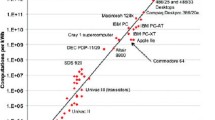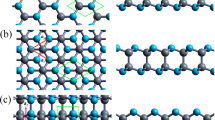Abstract
Besides graphene and hexagonal boron nitride, transition metal dichalcogenides (TMDs) also exhibit a layered structure in which the layers weakly interact via van der Waals forces. Semiconducting TMDs in bulk are indirect band gap materials. However, an isolated sheet exhibits a direct gap. This particular behavior makes them very attractive in terms of optical properties. Moreover, NbS2 and NbSe2 in bulk and their monolayers are metallic. Density functional theory calculations were carried out to study different TMD bilayer systems. First, different bilayer geometries with different stackings were considered. It was found that the indirect and direct band gaps compete; however, the indirect band gap always dominates. Surprisingly, bilayer heterostructures of different TMDs have been found to possess direct band gaps. Finally, heterobilayers composed of one metallic monolayer and a semiconducting layer are predicted as novel metallic van der Waals solids that might find applications in new two-dimensional nanodevices.







Similar content being viewed by others
References
J.A. Wilson and A.D. Yoffe: Transition metal dichalcogenides discussion and interpretation of observed optical, electrical and structural properties. Adv. Phys. 18(73), 193 (1969).
R.F. Frindt: Single crystals of MoS2 several molecular layers thick. J. Appl. Phys. 37(4), 1928 (1966).
R.F. Frindt: Optical absorption of a few unit-cell layers of MoS2. Phys. Rev. 140(2A), 536 (1965).
P. Joensen, R.F. Frindt, and S.R. Morrison: Single-layer MoS2. Mater. Res. Bull. 21(4), 457 (1986).
P.D. Fleischauer: Fundamental-aspects of the electronic-structure, materials properties and lubrication performance of sputtered MoS2 Films. Thin Solid Films 154(1–2), 309 (1987).
J.M. Martin, C. Donnet, T. Lemogne, and T. Epicier: Superlubricity of molybdenum-disulfide. Phys. Rev. B 48(14), 10583 (1993).
L. Rapoport, N. Fleischer, and R. Tenne: Applications of WS2 (MoS2) inorganic nanotubes and fullerene-like nanoparticles for solid lubrication and for structural nanocomposites. J. Mater. Chem. 15(18), 1782 (2005).
R. Tenne, L. Margulis, M. Genut, and G. Hodes: Polyhedral and cylindrical structures of tungsten disulfide. Nature 360(6403), 444 (1992).
L. Margulis, G. Salitra, R. Tenne, and M. Talianker: Nested fullerene-like structures. Nature 365(6442), 113 (1993).
R. Tenne, L. Margulis, and G. Hodes: Fullerene-like nanocrystals of tungsten disulfide. Adv. Mater. 5(5), 386 (1993).
L. Mattheis: Band structures of transition-metal-dichalcogenide layer compounds. Phys. Rev. B 8(8), 3719 (1973).
F. Wypych and R. Schollhorn: 1T-MOS2, a new metallic modification of molybdenum-disulfide. J. Chem. Soc. Chem. Commun. (19), 1386 (1992).
D. Yang, S.J. Sandoval, W.M.R. Divigalpitiya, J.C. Irwin, and R.F. Frindt: Structure of single-molecular-layer MOS2. Phys. Rev. B 43(14), 12053 (1991).
R. Bissessur, M.G. Kanatzidis, J.L. Schindler, and C.R. Kannewurf: Encapsulation of polymers into MOS2 and metal to insulator transition in metastable MOS2. J. Chem. Soc. Chem. Commun. (20), 1582 (1993).
V. Petkov, S.J.L. Billinge, J. Heising, and M.G. Kanatzidis: Application of atomic pair distribution function analysis to materials with intrinsic disorder. Three-dimensional structure of exfoliated-restacked WS2: Not just a random turbostratic assembly of layers. J. Am. Chem. Soc. 122(47), 11571 (2000).
D.J. Rahn, S. Hellmann, M. Kallane, C. Sohrt, T.K. Kim, L. Kipp, and K. Rossnagel: Gaps and kinks in the electronic structure of the superconductor 2H-NbSe2 from angle-resolved photoemission at 1 K. Phys. Rev. B 85(22), 224532 (2012).
T.K. Wieting and M. Schluter: Electrons and Phonons in Layered Crystal Structures (D. Reidel, Dordrecht, Netherlands, 1979).
G. Seifert, H. Terrones, M. Terrones, and T. Frauenheim: Novel NbS2 metallic nanotubes. Solid State Commun. 115(12), 635 (2000).
D.E. Moncton, J.D. Axe, and F.J. Disalvo: Neutron-scattering study of charge-density wave transitions in 2H-TaSe2 and 2H-NbSe2. Phys. Rev. B 16(2), 801 (1977).
C.D. Malliakas and M.G. Kanatzidis: Nb-Nb interactions define the charge density wave structure of 2H-NbSe2. J. Am. Chem. Soc. 135(5), 1719 (2013).
K.F. Mak, C. Lee, J. Hone, J. Shan, and T.F. Heinz: Atomically thin MoS2: A new direct-gap semiconductor. Phys. Rev. Lett. 105(13), 136805 (2010).
H.L. Zeng, J.F. Dai, W. Yao, D. Xiao, and X.D. Cui: Valley polarization in MoS2 monolayers by optical pumping. Nat. Nanotechnol. 7(8), 490 (2012).
K.F. Mak, K.L. He, J. Shan, and T.F. Heinz: Control of valley polarization in monolayer MoS2 by optical helicity. Nat. Nanotechnol. 7(8), 494 (2012).
H. Wang, L.L. Yu, Y.H. Lee, Y.M. Shi, A. Hsu, M.L. Chin, L.J. Li, M. Dubey, J. Kong, and T. Palacios: Integrated circuits based on bilayer MoS2 transistors. Nano Lett. 12(9), 4674 (2012).
W.S. Hwang, M. Remskar, R.S. Yan, V. Protasenko, K. Tahy, S.D. Chae, P. Zhao, A. Konar, H.L. Xing, A. Seabaugh, and D. Jena: Transistors with chemically synthesized layered semiconductor WS2 exhibiting 105 room temperature modulation and ambipolar behavior. Appl. Phys. Lett. 101(1), 013107 (2012).
Y.J. Zhang, J.T. Ye, Y. Matsuhashi, and Y. Iwasa: Ambipolar MoS2 thin flake transistors. Nano Lett. 12(3), 1136 (2012).
H. Fang, S. Chuang, T.C. Chang, K. Takei, T. Takahashi, and A. Javey: High-performance single layered WSe2 p-FETs with chemically doped contacts. Nano Lett. 12(7), 3788 (2012).
Q.A. Wang, K. Kalantar-Zadeh, A. Kis, J.N. Coleman, and M.S. Strano: Electronics and optoelectronics of two-dimensional transition metal dichalcogenides. Nat. Nanotechnol. 7, 699 (2012).
N. Perea-López, A.L. Elías, A. Berkdemir, A. Castro-Beltran, H.R. Gutiérrez, S. Feng, R. Lv, T. Hayashi, F. López-Urías, S. Ghosh, B. Muchharla, S. Talapatra, H. Terrones, and M. Terrones: Photosensor device based on few-layered WS2 Films. Adv. Funct. Mater. (2013) DOI: 10.1002/adfm.201300760.
M. Chhowalla, H.S. Shin, G. Eda, L.J. Li, K.P. Loh, and H. Zhang: The chemistry of two-dimensional layered transition metal dichalcogenide nanosheets. Nat. Chem. 5(4), 263 (2013).
R.A. Bromley, A.D. Yoffe, and R.B. Murray: Band structures of some transition-metal dichalcogenides. III. Group VIA-trigonal prism materials. J. Phys. C: Solid State Phys. 5(7), 759 (1972).
S. Lebegue and O. Eriksson: Electronic structure of two-dimensional crystals from ab initio theory. Phys. Rev. B 79(11), 115409 (2009).
T. Boker, R. Severin, A. Muller, C. Janowitz, R. Manzke, D. Voss, P. Kruger, A. Mazur, and J. Pollmann: Band structure of MoS2, MoSe2, and alpha-MoTe2: Angle-resolved photoelectron spectroscopy and ab initio calculations. Phys. Rev. B 64(23), 235305 (2001).
H. Jiang: Electronic band structures of molybdenum and tungsten dichalcogenides by the GW approach. J. Phys. Chem. C 116(14), 7664 (2012).
T. Cheiwchanchamnangij and W.R.L. Lambrecht: Quasiparticle band structure calculation of monolayer, bilayer, and bulk MoS2. Phys. Rev. B 85(20), 205302 (2012).
A. Enyashin, S. Gemming, and G. Seifert: Nanosized allotropes of molybdenum disulfide. Eur. Phys. J. Spec. Top. 149, 103 (2007).
H. Terrones, F. Lopez-Urias, and M. Terrones: Novel hetero-layered materials with tunable direct band gaps by sandwiching different metal disulfides and diselenides. Sci. Rep. 3, (2013).
J.C. Wildervanck and F. Jellinek: Preparation and crystallinity of molybdenum and tungsten sulfides. Z. Anorg. Allg. Chem. 328(5–6), 309 (1964).
P.R. Bonneau, R.F. Jarvis, and R.B. Kaner: Rapid solid-state synthesis of materials from molybdenum-disulfide to refractories. Nature 349(6309), 510 (1991).
P.B. James and M.T. Lavik: Crystal structure of MoSe2. Acta Crystall. 16(11), 1183 (1963).
A.L. Elías, N. Perea-López, A. Castro-Beltrán, A. Berkdemir, R. Lv, S. Feng, A.D. Long, T. Hayashi, Y.A. Kim, M. Endo, H.R. Gutiérrez, N.R. Pradhan, L. Balicas, T.E. Mallouk, F. López-Urías, H. Terrones, and M. Terrones: Controlled synthesis and transfer of large-area WS2 sheets: From single layer to few layers. ACS Nano 7(6), 5235 (2013).
T. Georgiou, R. Jalil, B.D. Belle, L. Britnell, R.V. Gorbachev, S.V. Morozov, Y.J. Kim, A. Gholinia, S.J. Haigh, O. Makarovsky, L. Eaves, L.A. Ponomarenko, A.K. Geim, K.S. Novoselov, and A. Mishchenko: Vertical field-effect transistor based on graphene-WS2 heterostructures for flexible and transparent electronics. Nat. Nanotechnol. 8(2), 100 (2013).
S.J. Clark, M.D. Segall, C.J. Pickard, P.J. Hasnip, M.J. Probert, K. Refson, and M.C. Payne: First principles methods using CASTEP. Z. Kristallogr. 220(5–6), 567 (2005).
D.M. Ceperley and B.J. Alder: Ground-state of the electron-gas by a stochastic method. Phys. Rev. Lett. 45(7), 566 (1980).
J.P. Perdew and A. Zunger: Self-interaction correction to density-functional approximations for many-electron systems. Phys. Rev. B 23(10), 5048 (1981).
F. Ortmann, F. Bechstedt, and W.G. Schmidt: Semiempirical van der Waals correction to the density functional description of solids and molecular structures. Phys. Rev. B 73(20), 205101 (2006).
J.P. Perdew, J.A. Chevary, S.H. Vosko, K.A. Jackson, M.R. Pederson, D.J. Singh, and C. Fiolhais: Atoms, molecules, solids, and surfaces: Applications of the generalized gradient approximation for the exchange and correlation. Phys. Rev. B 46(11), 6671 (1992).
Y. Ding, Y. Wang, J. Ni, L. Shi, S. Shi, and W. Tang: First principles study of structural, vibrational and electronic properties of graphene-like MX2 (M=Mo, Nb, W, Ta; X=S, Se, Te) monolayers. Physica B 406(11), 2254 (2011).
S.K. Mahatha, K.D. Patel, and K.S.R. Menon: Electronic structure investigation of MoS2 and MoSe2 using angle-resolved photoemission spectroscopy and ab initio band structure studies. J. Phys. Condens. Matter 24(47), 475504 (2012).
K. Refson, P.R. Tulip, and S.J. Clark: Variational density-functional perturbation theory for dielectrics and lattice dynamics. Phys. Rev. B 73(15), 155114 (2006).
ACKNOWLEDGMENTS
This work is supported by the U.S. Army Research Office MURI Grant No. W911NF-11-1-0362, supported in part by the Materials Research Computing and Cyberinfrastructure unit of Information Technology Services and Penn-State Center for Nanoscale Science. M.T. also acknowledges support from the Penn State Center for Nanoscale Science for seed grant on 2-D layered materials (Grant No. DMR-0820404).
Author information
Authors and Affiliations
Corresponding author
Additional information
This author was an editor of this focus issue during the review and decision stage. For the JMR policy on review and publication of manuscripts authored by editors, please refer to http://www.mrs.org_jmr_policy.
Rights and permissions
About this article
Cite this article
Terrones, H., Terrones, M. Bilayers of transition metal dichalcogenides: Different stackings and heterostructures. Journal of Materials Research 29, 373–382 (2014). https://doi.org/10.1557/jmr.2013.284
Received:
Accepted:
Published:
Issue Date:
DOI: https://doi.org/10.1557/jmr.2013.284




